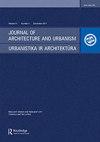阅读过去:分析流行病对城市的影响
IF 0.8
0 ARCHITECTURE
引用次数: 0
摘要
纵观历史,数十种流行病周期性地出现,往往造成毁灭性的影响。其中一些流行病,如鼠疫、霍乱和肺结核,导致了重大的社会、经济和政治后果,对城市和建筑产生了明显的影响。在这方面,城市规划在提高预期寿命和限制流行病传播方面发挥了至关重要的作用。本作品旨在研究几个世纪以来流行病对建筑和城市规划的影响,以理解它们对新的健康和社会要求的回应和适应。通过对文献综述的调查和深入研究,我们得以了解流行病对城市的影响。鼠疫时期出现的第一批预防措施、为抗击霍乱爆发而采取的城市干预措施,以及肺结核出现后所采用的整齐的建筑特征,都是这一过程的见证。专业人士和学者们正在思考 19 世纪科维德大流行所带来的挑战,这将影响到建筑和城市设计的实践。通过所取得的成果,我们可以反思大流行病对当代城市的影响,了解其潜在的复原力,并对未来的战略提出假设。本文章由计算机程序翻译,如有差异,请以英文原文为准。
READING THE PAST: ANALYSIS OF THE IMPACT OF PREVALENT PANDEMICS ON CITIES
Throughout history, dozens of epidemics have appeared cyclically, often causing devastating effects. Some of them, such as plague, cholera, and tuberculosis, have led to significant social, economic, and political consequences, with evident repercussions on cities and architecture. In this regard, urban planning has played an essential role in improving life expectancy and limiting the spread of epidemics. This work aims to study the influence of prevalent pandemics on architecture and urbanism over the centuries to comprehend their response and adaption to new health and social requirements. Through a process of investigation and in-depth examination of the literature review, it has been possible to understand the impact of pandemics in cities. The appearance of the first preventive measures during the plague period, the urban interventions to combat the cholera outbreak, and the neat architectural features adopted following the appearance of tuberculosis are witnesses to this process. Professionals and academics are reflecting on the challenges of the Covid-19 pandemic, which will affect the practice of architecture and urban design. Thanks to the results obtained, it will be possible to reflect on the impact of the pandemic on contemporary cities, understand their potential resilience and hypothesise future strategies.
求助全文
通过发布文献求助,成功后即可免费获取论文全文。
去求助
来源期刊

Journal of Architecture and Urbanism
ARCHITECTURE-
CiteScore
1.30
自引率
14.30%
发文量
12
审稿时长
15 weeks
期刊介绍:
The Journal of Architecture and Urbanism publishes original research on all aspects of urban architecture.
 求助内容:
求助内容: 应助结果提醒方式:
应助结果提醒方式:


